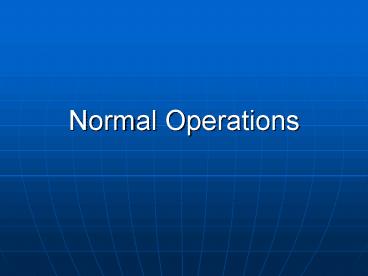Normal Operations - PowerPoint PPT Presentation
1 / 13
Title: Normal Operations
1
Normal Operations
2
What are we going to do today?
- Upload proper formula
- Start skid process
- Adjust Brine and Citric addition rate as needed
- Adjust heat exchanger temperature set point (line
13 only) - Demonstrate how to operate Beckman and Brookfield
instruments - Calibrate Beckman pH meter
- Identify pH range for an acid and a base
- Explain the need for adding citric acid to some
formulas - Tote and Drum Change
- Lock out loops
- Change totes and / or drums prior to surge tank
low level - Restart loops
3
The Basics
- How to upload a formula can be found in all of
our changeover SOPs. - How to start the skid process and what to look
for is in every changeover SOP, and some was
covered in your first few Operation Technician
Three training. - Making Citric Acid and Brine adjustments can be
complicated when not understanding when to do it
or why we need to do it. - Question you need to ask yourself
- What is my specification range for viscosity and
or pH. - How do you trend your adjustments
- What test can you do to confirm you have made the
correct decision
4
Heat Exchanger for Line 13
Line 13 Heat Exchanger. Manual controls in
electric room 5
Heat exchanger temperature controls can be seen
on the bottom of the formula screen. When heat
exchanger is active. Heat exchanger will turn
RED!
5
K-TRON BEAD FEEDER
These are the screws we use on line 13
Our materials are held in a hopper and constantly
feed into refill hopper. As the feeder discharges
material, system weight declines. The
loss-in-weight feeder controller adjusts feeder
speed to produce a rate of weight loss or process
variable equal to the desired feed rate setpoint.
When adding materials to the system while
processing, we are adding weight to the system in
error. We required the system to make adjustments
of speed based on erroneous information. That is
why we require operators to not add materials
while the line is processing. Simple vibrations
and putting objects on the systems load cells
will also require the system to make adjustments
based on erroneous information.
6
Beckman pH meter
A simple and speedy device to measure the acidity
and alkalinity of a fluid. A pH meter acts as a
volt meter that measures the electrical potential
difference between a pH electrode and a reference
electrode and displays the result in terms of the
pH value of the solution in which they are
immersed. The pH meter was invented in 1934 by
the American chemist Arnold O. Beckman
(1900-2004) to measure the sourness of lemons.
Beckman's original device was housed in a walnut
box 12 inches wide, 8 inches deep and 9 inches
high. It measured electrical current flowing into
a glass electrode immersed in a solution. The
amount of current indicated the solution's
acidity.
7
Brookfield
The ability to gather data on a material's
viscosity behavior gives manufacturers an
important "product dimension". Knowledge of a
material's rheological characteristics is
valuable in predicting pumpability and
pourability, performance in a dipping or coating
operation, or the ease with which it may be
handled, processed, or used. The interrelation
between rheology and other product dimensions
often makes the measurement of viscosity the most
sensitive or convenient way of detecting changes
in color, density, stability, solids content, and
molecular weight.
8
Temperature!
- Temperature one of the most obvious factors that
can have an effect on the rheological behavior of
a material. Some materials are quite sensitive to
temperature, and a relatively small variation
will result in a significant change in viscosity.
Others are relatively insensitive. - Testing our products at 25 degrees Celsius and
the change in viscosity at a degree higher or
lower helps us understand the need for accuracy
and just how temperamental our products can be!
9
Effect of Temperature
10
Changing totes and restarting skid to process
- Disconnect post add containers for the prior
formula and hook up the containers for the new
formula using clean hoses. Place the previously
used hoses on the hose-cleaning cart. - Place the out-feed for the recirculation loop in
a clean container for purging. - Manually adjust the control valves (if applied)
to 85. - Manually open in-feed valve.
- Start the pumps at 50 capacity and purge both
for approximately 15 seconds. Monitor the
color/appearance of the effluent to ensure
effectiveness and purge longer if needed. - Close post-add pump in-feed valves when the purge
process is complete. - Remove the out-feed for the recycle loops from
the clean containers used for purging and place
in the proper feed containers.
11
Questions?
12
Feedback
- Ongoing improvement requires feedback Give
some!
13
Your Assessment Responsibilities
- You will need to demonstrate the ability to
upload proper formula with a clear understanding
on the how to start skid process. - Demonstrate the ability to make brine and citric
acid adjustment and give examples of how and why
we do this. - Give examples and state products that require the
use of the heat exchanger and demonstrate the
path of flow through the heat exchanger. - Obtain instructions from your trainer and proceed
to calibrate the Beckman pH meter. - Obtain a sample from any production line and
proceed to do a Beckman pH meter test and do a
Brookfield viscosity test. - Describe the reasoning behind the desire
temperature value of 25 degrees Celsius - Adjust heat exchanger temperature set point (line
13 only). If the product is too hot or cold what
does that do to our viscosity and fill weights? - Why can we not add beads to the K-TRON feeder why
line is processing? - Tote and Drum Change, what are the procedures for
changing a tote or drum?































